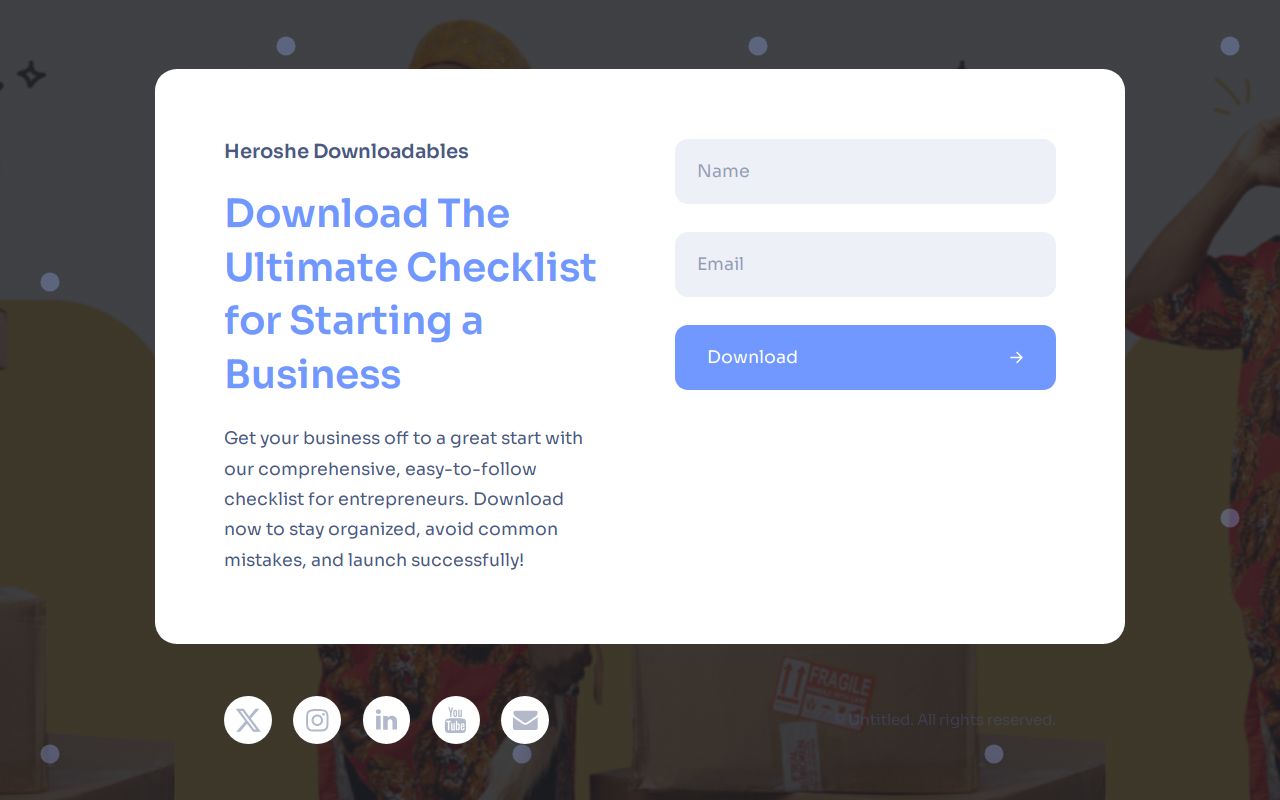The Ultimate Checklist for Starting a Business

Alicia wants to leave her corporate career to start a bakery, something she has always been passionate about. She thought, “is it not just to rent a space, get all the items needed and start baking my special banana bread?” But she was met with a shocker when Nicki, her friend who is a business analyst, gave a long list of things she needed to check before launching. Alicia was like, “whatttttt? I didn’t plan for all of this, Nicki. I thought it was just to open a shop and start baking?” “Well, now you know what and what to do, so get to work and stop whining”, Nicki responded.
Like Alicia, many aspiring entrepreneurs are oblivious to what they need to start a business. They see the excitement and sometimes the popularity of being an entrepreneur and want to get in. But, owning a business is rewarding, tiring, and challenging. There are many steps to take, decisions to make, and tasks to complete. The list is endless.
This is where our ultimate business startup checklist comes in. It's designed to guide you through the entire process, from refining your business idea to launching your business. It provides a roadmap to success and a clear path to your entrepreneurial goals.
Ready to embark on your entrepreneurial journey? Let's get started with our checklist.
Download our Ultimate Checklist for Starting A Business
Idea and Validation
Define Your Business Idea
Your business journey begins with an idea. It's the seed from which your venture will grow. But not all ideas are created equal. It's necessary to define your idea and your unique value proposition (what sets you apart from the competition).
Ask yourself, what problem does your business solve? How does it stand out from the competition? Your answers will form the foundation of your business. They'll guide your decisions and strategies moving forward.
Conduct Market Research
Once you've defined your business idea, it's time to validate it. This is where market research comes in. It's about understanding the market you're about to enter. You need to know if there's a demand for your product or service.
Look at market trends, customer behaviour, and economic conditions. This will help you gauge your business's viability. Remember, a great idea is only as good as the market's readiness. As Gary Halbert would say, “You need to be a student of markets before launching a business.”
Related: What Are the Best High-Demand Products for 2024?
Identify Your Audience
Identifying your target audience and building a buyer persona will help you identify your customers and understand their needs, preferences, and buying habits.
This information will guide your marketing efforts and help you tailor your products or services to meet your customers' needs. In defining your target audience, it is important to note that a business that tries to cater to everyone often appeals to no one.
Analyse Your Competition
You are likely not the only person doing what you do, so you must understand your competition. Conducting a competitive analysis will help you find your unique selling proposition. Start by identifying businesses that offer similar products or services. Then, analyse their strengths and weaknesses, marketing strategy, operations, and customer behaviour.
This analysis will help you find gaps in the market. It will also help you understand what makes your business unique. Use this information to position your business in a way that sets it apart from the competition.
Legal & Financial
Decide on Your Business Structure
The legal structure of your business affects your liability, taxes, and administrative requirements. Common structures include sole proprietorship, partnership, limited liability company (LLC), and corporation. Each has its advantages and disadvantages.
Consider your business needs, financial situation, and long-term goals when deciding on a structure. It's advisable to consult with a business advisor or lawyer to make an informed decision.
Choose and Register a Business Name
Choosing a business name is a crucial step in the startup process. Your business name should be memorable, relevant to your industry, and resonate with your target audience. It's also important to check if the name is available as a web domain.
Once you've chosen a name, you'll need to register it. The process varies depending on your business structure and location. To avoid legal issues, you should also check for trademark availability.
Obtain Necessary Licenses and Permits
Starting a business often requires obtaining specific licenses and permits. These vary based on your business type, location, and government regulations. They may include business licenses, sales tax licenses, health permits, etc.
Ensure you research and understand the legal requirements for your business. Non-compliance can lead to fines, penalties, or even business closure. Consider consulting with a business lawyer to help you navigate this process.
Set Up Business Bank Accounts
Managing your business finances is crucial for the success of your startup. This involves setting up a business bank account and establishing an accounting system.
A business bank account separates your personal and business finances. This separation is essential for tax purposes and gives your business a professional image to customers and suppliers. Choose a bank that offers services tailored to your business needs, such as online banking, credit card processing, and payroll services.
An accounting system helps you track income, expenses, and taxes. You can use accounting software or hire a professional accountant to ensure accurate and compliant financial management.
Secure Funding for Your Business
Securing funding is a critical step in starting your business. The type of funding you choose depends on your business needs, financial situation, and the control you wish to maintain over your business.
There are several ways to fund your startup. You can use personal savings, loans from family and friends, bank loans, or investors. Alternatively, you can consider crowdfunding or applying for grants. Each funding option has pros and cons, so it's important to carefully evaluate your options and choose the one that best fits your business model and growth plans.
Business Planning
Write a Detailed Business Plan
A business plan is a roadmap for your business. It outlines your business goals and the steps you plan to take to achieve them. It's a crucial tool for securing funding and tracking your progress.
Your business plan should include the following sections:
Executive Summary: A brief overview of your business.
Company Description: Detailed information about your business, including mission, vision, goals, your products or services and your target market.
Market Analysis: An overview of your industry and competition.
Location Analysis: An analysis of your business location and why you think it’s a good place for your business.
Organisation and Management: Your business structure and the team running it.
Service or Product Line: What you're selling or the service you're offering.
Marketing and Sales: Your strategy for attracting and retaining customers.
Funding Request: Outline your current funding requirements if you're seeking funding.
Financial Projections: Provide an outlook for the future of your business.
Your business plan is a living document that should evolve as your business grows and changes.
Create a Detailed Budget
Budgeting and financial projections help you plan for the future. They allow you to anticipate income, manage expenses, and ensure profitability. Consider the following when creating your budget:
Startup costs: These are one-time costs for things like equipment, inventory, and business registration.
Fixed costs: These are recurring costs such as rent, utilities, and salaries.
Variable costs: These costs fluctuate based on your business activities, such as product raw materials.
Income projections: Estimate your future sales based on market research and industry benchmarks.
Determine your Pricing Strategy and Revenue Model
Over time, your pricing and revenue model will keep your business profitable.
The pricing strategy is the process of defining and deciding what you will charge for your products/ services. Will you choose a value-based, competitive, or cost-plus pricing strategy? Or will your pricing strategy be dynamic and change as your business grows?
The revenue model, on the other hand, shows how your business will make money from its products and services. There are several revenue models, including advertising-based, affiliate-based, commission-based, and subscription-based.
So, how will you define your pricing strategy and revenue model?
Product or Service Development
Develop your product or service offering
Your product or service offering is important to your business's growth. Everything you learn during the market research and competitive analysis phase will be used here to create a useful product for your audience.
This is also where you’ll specify the features and benefits of your product/ service. This has to be elaborate so anyone joining you in the future can understand all your product specifications.
Test your Product/Service with Potential Customers.
It is not enough to make product specifications and build a product. You also want to see what your audience thinks about it. So, you’ll do a prototype that can be used for testing.
During the testing phase, you want to ensure your testers are comfortable with everything that will happen and that you’re not influencing their feedback. Allow them to say everything they feel about the product/ service. Ask questions on areas where you are not clarified and ask for input they think will improve the product/ service.
Build on the feedback, improve the product, and reiterate. It is important to note that as your business grows and evolves, testing will be conducted at every stage.
Determine your Suppliers and Establish Relationships.
If you sell physical products, you will want to identify your suppliers and establish relationships with them. Your supplier is supposed to be your collaborator in product quality.
Understanding their capabilities and communicating clearly and frequently are the basis of building a strong relationship. Don’t forget to negotiate on pricing and quantity.
Related: How to Choose the Right Shipping Company for Your Business Needs
Marketing & Branding
Develop Your Brand Identity
When I see a swoosh sign, the first thing that comes to mind is Nike. Or is it when I see the yellow colour and immediately think MTN? Having a brand identity does this. It puts you at the top of the mind when your customers see certain symbols and colours. Your brand identity includes your logo, colours, font, tagline and the overall impression people have of your business. A strong brand can set you apart from competitors and build customer loyalty.
Create a Marketing Plan
A well-crafted marketing plan is crucial for reaching your target audience and driving sales. It outlines how you'll attract and retain customers. It includes advertising, public relations, digital marketing, and sales strategies.
Start by setting clear, measurable goals. Then, choose the marketing tactics that best reach your target audience. This could include social media advertising, email marketing, content marketing, or search engine optimisation. Monitor your results and adjust your strategies as needed. Effective marketing is about building customer relationships and delivering value, not just selling products or services.
Set Up Your Online Presence
In today's world, having an online presence is crucial. Start by creating a user-friendly SEO-optimised website where people can learn more about your business and what you offer.
Then, set up profiles on social media platforms like Facebook, Instagram, and Twitter. This is where you can connect with your audience and share updates about your business. The social media platforms you will choose will depend on where your target audience is. And, “If you’ve cast a wide net, you might find that your audience essentially hangs out on 4 or 5 social networks.”
Does this mean you will show up on all the platforms? The answer is no. The marketing guru Neil Patel says to “limit your presence to the online marketing platforms that will help you connect with a majority of the audience.” For example, you can’t be a makeup artist or fashion designer focusing all your energy on LinkedIn. It will be counterproductive.
You should also regularly post engaging content that provides value to your audience and use email marketing to stay connected with your customers. Don’t forget to monitor and respond to online reviews and feedback.
Plan your Launch Strategy
Launching your business is an exciting time, but it's important to have a plan in place. Decide when and how you want to launch, and make sure you have everything in place to make a big splash. This might include hosting an event, offering special promotions, or contacting influencers to help spread the word. The key is to keep things simple and focused on reaching your audience in a way that resonates with them.
Establish Operational Processes and Workflows
Running a business involves a multitude of tasks, processes, and workflows. It's essential to note all these processes and have systems to handle them efficiently.
Consider using business management software to streamline tasks. This can include accounting software, customer relationship management systems, and project management tools. Also, develop a routine that lets you stay on top of all aspects of your business.
Purchase Equipment and Supplies
The equipment and supplies you need will depend on your business type. For instance, a fashion design business may require sewing machines, threads and needles, weaving machines, and other things like tapes, scissors, and chalks. In contrast, a craft business might need crafting tools, materials, and packaging supplies.
Remember to factor these costs into your startup budget. You should also consider whether leasing or buying equipment is more cost-effective for your business. Always aim for quality over quantity, as reliable equipment can save you money in the long run.
Set Up Inventory Management Systems if Applicable
An inventory management system will help you keep track of your products or supplies so you never run out when customers need them. Having one can make a difference in managing your inventory and customer expectations.
Download our Ultimate Checklist for Starting A Business
Legal Compliance and Risk Management
Legal compliance and risk management are crucial to running any business or organisation.
Legal compliance means following the rules and regulations set by the government and other authorities. These rules are there to make sure that businesses operate fairly, ethically, and within the law. When you comply with these rules, you're playing by the book.
Risk management is about identifying, assessing, and dealing with potential risks that could affect your business. Risks can come from anywhere - economic changes, natural disasters, or even mistakes from your team. Managing these risks means being prepared for the unexpected, including getting the necessary insurance coverage.
Launch Your Business
Now that you've completed all the preparatory steps, it's time to launch your business. This is a significant milestone, but it's just the beginning. The real work starts now as you strive to attract customers and make sales.
Stay focused and be prepared to adapt. You'll likely face challenges, but you can overcome them with persistence and a willingness to learn.
Continuous Improvement
Success doesn't happen overnight. It's a result of consistent effort and dedication. Keep learning and improving your product/ service. Seek feedback from customers and use them to improve your offering continually. Stay updated with happenings in your industry. Keep your goals in sight and celebrate each small victory along the way.

Conclusion
Starting a business is a journey filled with challenges and rewards. This comprehensive checklist provides a roadmap to navigate the process. Every business is unique, so adapt this guide to your needs. Stay persistent, learn from your experiences, and keep striving to build the business of your dreams.
Join the Heroshe community to receive more helpful tips like this.

